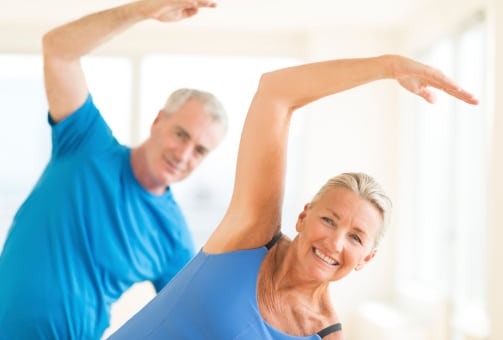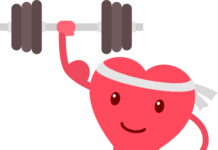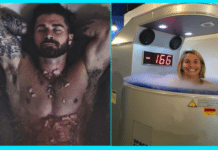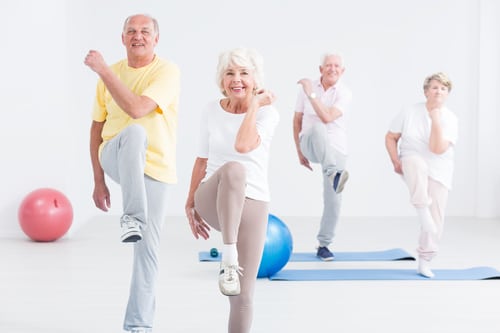Have you ever thought you’d like to take up ballroom dancing, yoga, or cycling, but then thought twice because you’re no longer in your 20s or 30s? It’s time to put such notions right out of your head, as when it comes to exercise age is just a number — and no “number” is too high to start getting active.
Your mind may actually be your biggest hurdle to staying fit and athletic well into your 80s and 90s, especially if you buy into the myth that you’ve got to spend your afternoons sitting in a rocking chair once you reach 75.
Nothing, and I mean nothing, could be further from the truth!
From Triathlons to Rodeos, Seniors Do it All
If you’re looking for a bit of “exercise” inspiration, look no further than this uplifting article from Happy News. It explains that more and more people are achieving stunning physical accomplishments in their “golden” years. Most of you are probably familiar with Jack LaLanne, who was the picture of fitness well into his 90s, but he is but one example. Others include:
- •Tao Porchon-Lynch, who is winning ballroom dance competitions and teaches at least 12 yoga classes a week at age 93.
- •Lew Hollander, who became the second 80-year-old to complete the Ford Ironman World Championship, which consists of a 2.4-mile swim, a 112-mile bike ride and a 26.2-mile marathon
- •Allan Johnson, who at age 80 still competes in rodeo competitions
Further, there are only four living people (and 16 in all history) who have earned a tenth-degree black belt, which is the highest rank in the martial art Judo. The fourth is not only the first woman to earn the title … she also did it at the age of 98. So if you’re having any thoughts that you’re “too old” to exercise, keep Sensei Keiko Fukuda (and the others listed above) in mind.
At age 98, she became the first woman to earn Judo’s highest-degree black belt, and she still teaches the martial art three times a week!
Not everyone has to become a world-class athlete to stay in shape, of course. Many communities have senior baseball leagues, swim teams, and other group sports that you can take part in, or you can simply exercise regularly with a personal trainer or on your own. The key to keep in mind is that the more active you are, the healthier, more nimble and happier you’ll be — AND …
You are Never Too Old to Start Exercising
You are never too old to start exercising and my mother is an excellent example.
Exercise can be a part of your life no matter what your age, and, in fact, becomes only increasingly important as you get older. Two years ago, my mother fell down a flight of stairs and broke her shoulder and wrist. It took quite awhile for her to recover, and when she did she started an exercise program to regain strength, balance, and flexibility.
My mom didn’t start working out until she was 74 and now, at the age of 77, she has gained significant improvements in strength, range of motion, balance, bone density and mental clarity. After a bit of apprehension at first, she now, as you can see on the video, loves her workouts and, I’m hoping, will inspire you to get active as well, no matter what your age.
Yes, You Can Exercise at ANY Age
There’s an overwhelming amount of evidence confirming that physical exercise is a key player in disease reduction, optimal mental, emotional and physical health, and longevity. After reviewing 40 papers published between 2006 and 2010, researchers found that exercise reduces the risk of about two dozen health conditions, ranging from cancer and heart disease to type 2 diabetes, stroke, dementia and depression. Exercise also slows down the rate of aging itself, providing perhaps the closest example of a real life fountain of youth as we will ever find.
Ideally, you will have made exercise a regular part of your life long before you reach your “golden” years … but if you haven’t, there’s no better time to start than the present. Research has shown that regular exercise, even initiated late in life, offers profound health benefits. For instance:
- •Even a small amount of exercise may protect the elderly from long-term memory loss and even help reverse some of the effects of aging.
- •Women between the ages of 75 and 85, all of whom had reduced bone mass or full-blown osteoporosis, were able to lower their fall risk with strength training and agility activities.
- •Moderate exercise among those aged 55-75 may cut the risk of developing metabolic syndrome, which increases heart disease and diabetes risk.
- •Among those who started exercising at age 50 and continued for 10 years, the rate of premature death declined dramatically, similar to giving up smoking and mirroring the level as seen among people who had been working out their entire lives.
- •Exercise significantly improved muscle endurance and physical capacity among heart failure patients with an average age of 76.
Further, the older you get, the faster your muscles atrophy if you’re not regularly engaging in appropriate exercise, so the key to avoiding sarcopenia (age-related muscle loss) is to challenge your muscles with appropriately intense exercise. Age-related muscle loss affects about 10 percent of those over 60, with higher rates as age advances, but you can prevent this from occurring if you exercise.
For the Elderly Exercise Can, Quite Literally, Save Your Life
Exercise is a key to remaining steady on your feet as you get older, which is of incredible importance because not only are falls responsible for most fractures and traumatic brain injuries among the elderly, but those who fall can also develop an intense fear of falling again, which leads them to limit their activities and in turn increases their risk of falling even more.
So while it may seem like exercises to improve balance and strength are optional as you get older, they should really be viewed as a necessity — like eating and sleeping — as they can quite literally save your life. As you get older your muscle and bone mass decrease and the senses that guide your balance — vision, touch, proprioception — may all start to deteriorate, and this can make you unsteady on your feet.
By taking the time to do balance, strength and other exercises on a regular basis you can keep your sense of balance strong, and even restore what’s already been lost.
In a study published last year, eight weeks of balance training reduced slips and improved the likelihood of recovery from slips among the elderly. Separate research, which noted that “altered balance is the greatest collaborator towards falls in the elderly,” found balance training is effective in improving functional and static balance, mobility and falling frequency in elderly women with osteoporosis.
The ability to balance on one leg is also an important predictor of injury-causing falls, so if you know that you’d be shaky if you tried to stand on one foot, you’re at an increased risk of being hurt in a fall and should start appropriate exercises immediately.
Making Exercise Safe and Effective

In the videos above you’ll hear Darin mention safety a number of times. This is always an important aspect of exercise, but is of crucial importance if you’re older and just beginning. Many elderly people forgo exercise altogether because of a fear of injury or pain, but what’s important to remember is that proper exercise will ultimately reduce your risk of injury as well as help to improvepain.
As Darin mentioned, if you’re older it’s best to get a workout buddy — a personal trainer or someone who is experienced — to help guide you through your routine, at least at first. You will want to start slowly and gradually increase intensity as you grow stronger, avoiding activities that aggravate or cause pain. While you need to use caution and avoid starting out too intensely, you do need to exercise at a level that is challenging to your body or the benefits will be lost.
Ideally your fitness program should be comprehensive, providing the necessary balance-training activities for stability while also improving your strength, flexibility, cardiovascular fitness and fat-burning capabilities with high-intensity “Sprint 8” exercises. Just like strength training, you are never too old for anaerobic Sprint 8 exercises. The only difference is that the older you are the less your maximum heart rate will be, but you still work out with the same intensity.
During the ‘Sprint 8 exercises,’ you raise your heart rate up to your anaerobic threshold for 20 to 30 seconds, followed by a 90-second recovery period. You repeat this cycle for a total of eight repetitions. For an in-depth explanation of the Peak Fitness regimen, be on the look out for an upcoming post on this. Depending on your fitness level, you may need to perform Sprint 8 exercises while walking or riding a stationary bike.
As I mentioned earlier, regular exercise is essential to counteract muscle loss. However, it’s important to realize that simply lifting weights will not necessarily result in gaining muscle mass. In order to effectively build muscle you also need to incorporate high-intensity exercises such as Sprint 8 in addition to strength training.
An Exciting Exercise Option for Building Balance
You can certainly build an excellent exercise program using nothing more than free weights, resistance bands and items you have around your home, but there is one form of exercise you may also want to consider, which is performed on a vibrational machine called the Power Plate.
This multi-directional vibration machine has a number of benefits for your health beyond the cardiovascular and metabolic aspects commonly associated with exercise. For example, the vibrational action of the Power Plate can help improve the following:
| Strength | Proprioception | Balance |
| Flexibility | Circulation | Neurological processes |
The tri-directional movement promotes proprioception, which is just a medical term for sensing the relative position of neighboring parts of your body. Proprioception is an internal feedback mechanism crucial for balance, as your body constantly adjusts to uneven terrain as you walk.
The unique ability of the Power Plate to train and build your neurological system has huge implications for treating people with neurological problems as well as elderly individuals who are prone to falls because of instability. As the video below shows, you can re-train motor patterns and re-establish communication within your body as the Power Plate balances muscle groups, resulting in profound improvements in your overall balance.
Now’s the Time to Take Control of Your Health
I’m very proud of my mom for taking control of her health and starting an exercise program in her 70s, and she is already experiencing the benefits. If you are older and currently weighing whether or not to start one of your own, please use your age as a reason to exercise, as opposed to an excuse not to.
If my mom can do it, there’s a good chance you will be able to too.
If you don’t have access to a personal trainer or experienced exerciser who can help guide you, many health clubs now offer fitness classes geared toward seniors, ranging from dance classes and water workouts to yoga and tai chi. The more active you are, and the wider the range of activities you do, the more mobile, independent and, likely, happy you will be as you get older.
One final tip — make sure you engage in activities you enjoy. There was one common thread among the elderly athletes mentioned above, and that is, as Happy News reported:
” … they absolutely love the activities they’ve found to do. Even if some of it is a hard slog, the pleasure they get from it always outweighs the tedium.”
Porchon-Lynch, the 93-year-old ballroom dancer and yoga teacher, expanded:
“Don’t be scared to live. Don’t procrastinate. There’s very little time on this Earth and there’s so much to do and so much beauty. … There’s nothing you can’t do.”
Sources and References
- Happy News August 29, 2011




























Its never too late and being 76 years young keeps me vibrant with my regular swimming meetups 5x week! Nice post!
Barb
Very inspiring Barb and you’ll probably out swim many of us! 😉
In Health,
Watzup Today